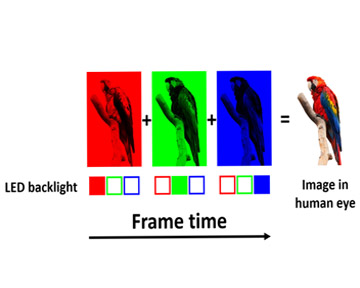
A new technology could allow field-sequential color displays where a single subpixel can be quickly switched among red, green or blue, allowing the three subpixels to become three independent pixels and tripling the resolution density. [Image: Yuge Huang and Ruidong Zhu, University of Central Florida]
Television display technology has made great strides over the past two decades, but some researchers still want to improve it. Now, an international team of researchers has tweaked blue-phase liquid crystals (BPLCs) to boost pixel density and resolution in future displays (Opt. Mater. Express, doi:10.1364/OME.7.000641).
A new blue
The blue phase of liquid crystals appears in a relatively narrow temperature range between the nematic and isotropic phases. BPLCs don't appear exclusively blue to the human eye; the term “blue phase” simply refers to the first microscopic observation of the phenomenon. They respond to signals in less than a millisecond, and their dark state is optically isotropic. However, they have remained in the laboratory for two reasons: their high operating voltage requirement makes BPLC devices power hogs, and slow capacitor charging limits the frame-refresh rate of displays.
The team, led by Shin-Tson Wu of the College of Optics and Photonics (CREOL) of the University of Central Florida, USA, worked with JNC Petrochemical Corp., Japan, to blend a new BPLC mixture—high in fluorinated multi-ring compounds—and test its properties in a standard in-plane switching cell.
The new solution had an average dielectric constant less than half of that of a commercially available BPLC mixture. Thus, its required charging time was around 250 μs, instead of 1.5 ms for the commercial solution. It also had a reasonable operating temperature range of –20 °C to 75 °C, wide enough for most indoor applications.
Sharpening images
In order to use the new BPLCs in a field-sequential display, however, the researchers still needed to lower the high operating voltage. Along with colleagues from AU Optronics Corp., Taiwan, the CREOL team created a triangular protrusion electrode, based on several other designs developed over the last decade. This single-transistor structure transmits current through the crystal better and reduces the operating voltage.
Thanks to fast response time, the new BPLC solution could be used in field-sequential color displays, which eliminates the red, green and blue filters traditionally used in liquid-crystal displays. Hence, the three colors could be shown in independent pixels for three times the resolution of current displays — for sharper television and more realistic virtual reality.
